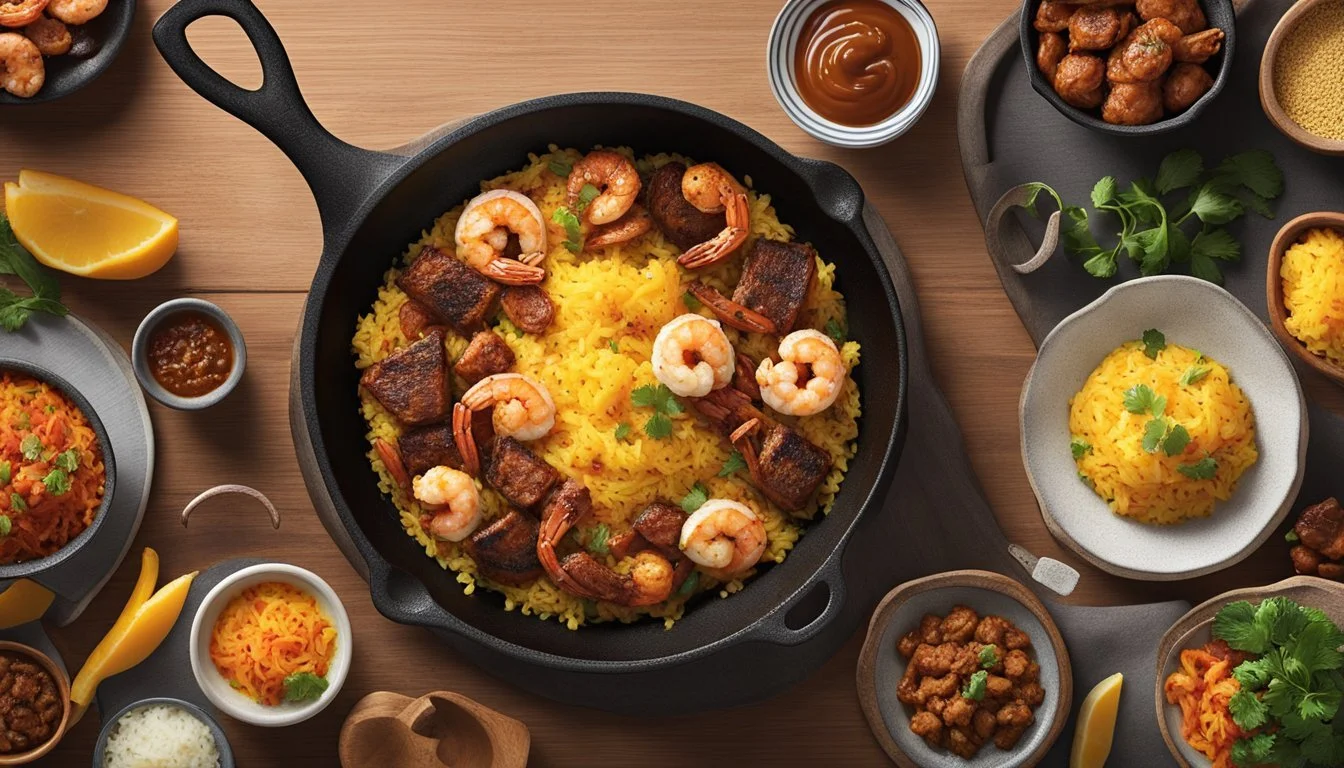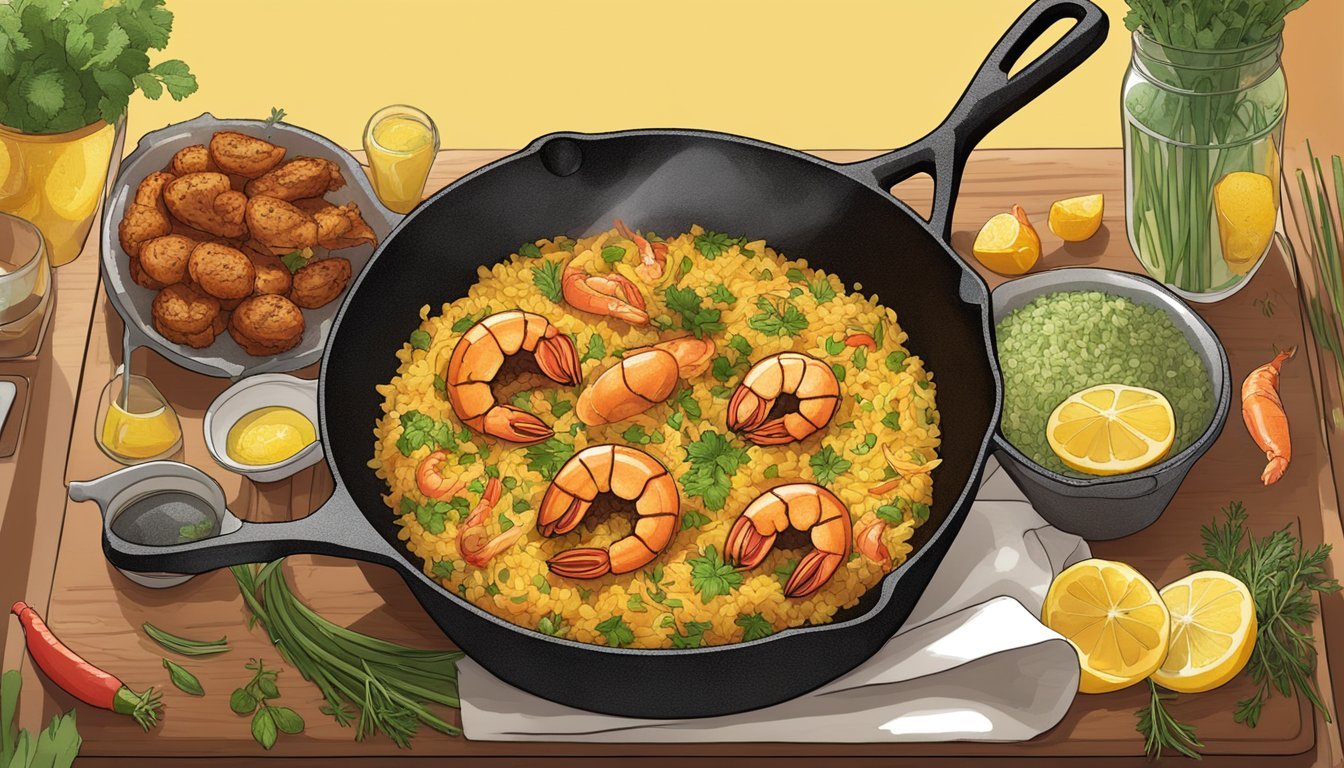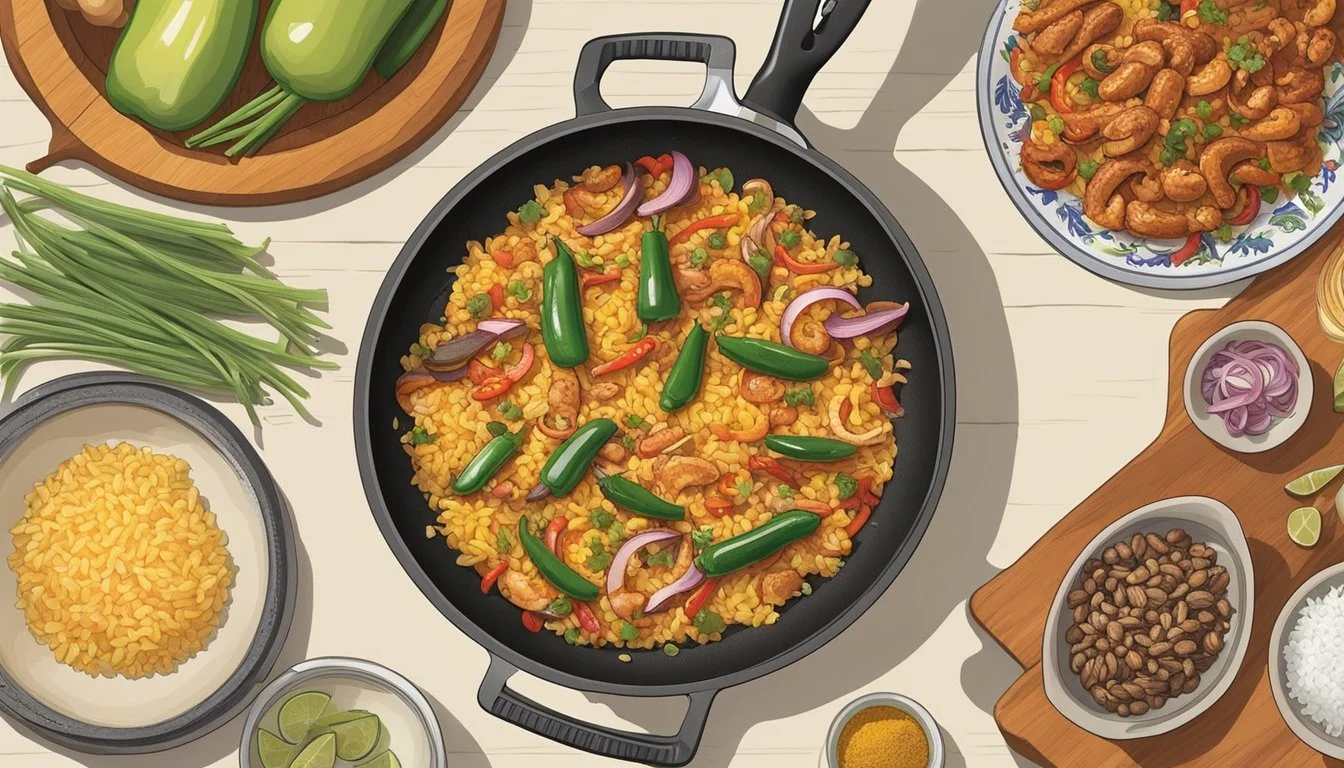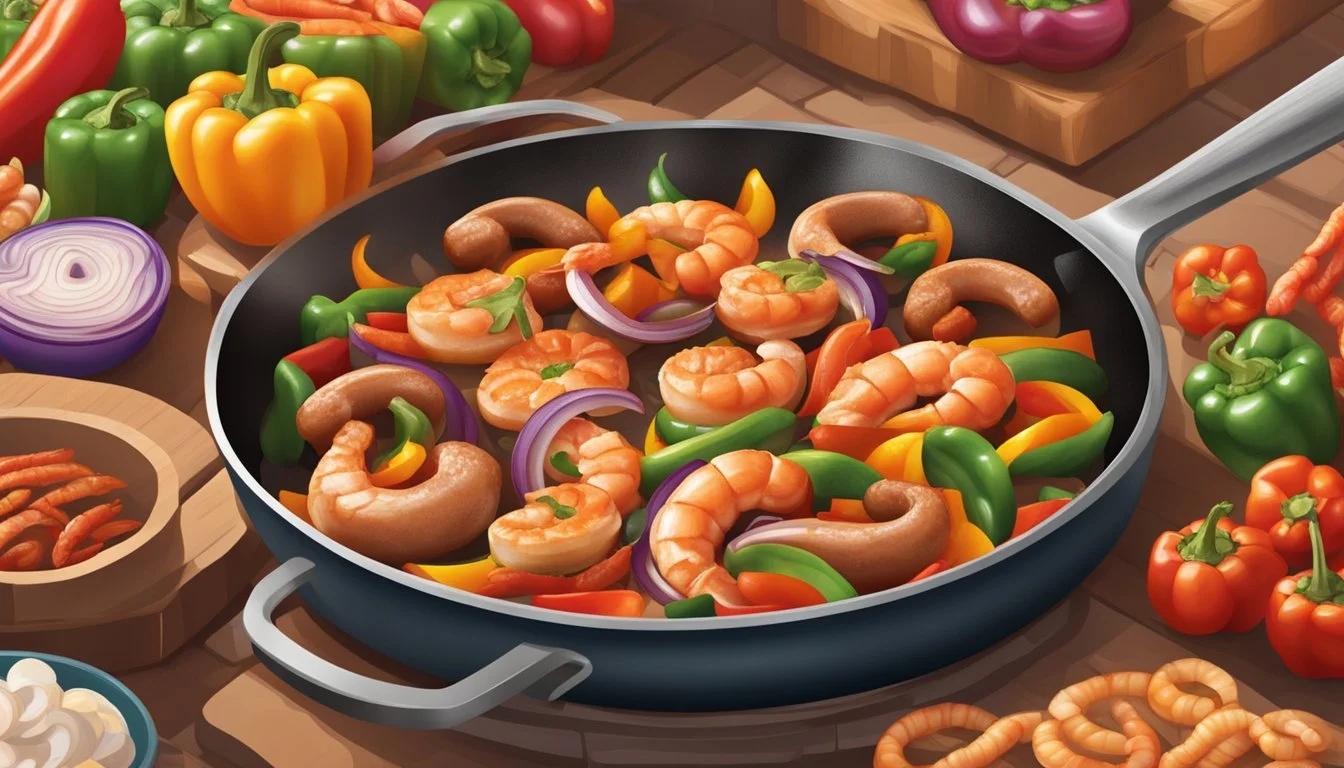How to Make a Texas-Style Paella
A Fusion Cuisine Guide
Paella, a vibrant and flavorful dish that originated from the Valencia region of Spain, has made its way across the globe and taken on many regional variations. One such adaptation is the Texas-Style Paella, a fusion that blends traditional Spanish cooking techniques with the robust flavors of the Lone Star State. By incorporating ingredients like local spices, meats, and seafood, Texans have put their unique stamp on this classic recipe, giving it a new identity that's as bold as it is delicious.
Creating a Texas-style paella involves marrying the foundational elements of Spanish paella with Texan ingredients. Typical paella's key components such as saffron, rice, and a variety of proteins are present, but the recipe diverges by introducing spices like cumin and paprika, which are more closely associated with Texan cuisine. Additionally, Texas paella might swap traditional proteins like rabbit and snails for more locally available options such as beef and Gulf shrimp, (What wine goes well with shrimp?) making the dish resonate with the regional palate.
The process for preparing this distinctive dish requires careful attention to the layering of flavors and textures. A seasoned cook begins by constructing a base of sofrito, a mixture of onions, peppers, and tomatoes sautéed in olive oil, which provides a deeply aromatic foundation. Depending on personal preference and the ingredients at hand, one might also incorporate local touches such as bacon or jalapeños at this stage. Following this, other ingredients are added in stages to ensure that each is perfectly cooked, allowing for a harmonious blend of flavors in the finished paella.
Essential Ingredients
The Texas-style paella fuses traditional Spanish elements with the robust flavors of the Lone Star State. Key ingredients include various proteins, locally-sourced vegetables, and a blend of spices and herbs, each playing a crucial role in creating a vibrant and flavorful dish.
Proteins
Chicken: A staple in paella, bone-in pieces will add flavor.
Steak: Top sirloin or flat iron steak, cut into chunks.
Shrimp: Fresh or frozen, peeled, and deveined.
Spanish Chorizo: This cured sausage adds a smoky depth.
Vegetables
Onions: Yellow onions are preferred for their sweetness.
Garlic: Integral for aroma; garlic should be used generously.
Tomatoes: Fire-roasted diced tomatoes can enhance the smokiness.
Red and Yellow Peppers: Slice into strips for sweetness and color.
Asparagus and Mushrooms: Optional depending on season and preference.
Sweet Peas: Add freshness and a pop of color.
Spices and Herbs
Saffron Threads: Essential for the signature yellow hue and aroma.
Paprika: Smoked paprika imparts a distinct warmth and color.
Salt and Ground Black Pepper: For basic seasoning.
Parsley: Flat-leaf parsley leaves, chopped for garnish.
The blend of these ingredients will result in a paella that honors its Valencian roots while showcasing the hearty character of Texas cuisine.
Preparation of the Base
For a successful Texas-Style Paella, constructing a flavorful base is pivotal. The base layers should consist of a richly prepared sofrito, well-browned meats, and properly prepared seafood, each contributing to the overall depth of flavor.
Making the Sofrito
Sofrito serves as the foundation for flavor in paella. A cook should begin by heating olive oil in the paella pan over medium heat. They need to finely mince several garlic cloves and chop onions, adding them to the pan with diced jalapeños for a Texas twist. Key spices like smoked sweet paprika, saffron, and a pinch of salt are also added. This mixture should be stir-fried for 5 to 7 minutes until the onions are translucent, and the aroma of the spices is evident.
Browning the Meats
Once the sofrito is set, the chef introduces the meats. They could range from traditional rabbit to regional favorites like sausage (chorizo or similar). The meats should be added to the nonstick skillet or cast iron skillet if a paella pan isn't available, with a coat of olive oil over medium heat. Here, they need to be sautéed until they obtain a golden-brown exterior, ensuring a rich flavor. This browning process also introduces fond—the browned bits at the bottom of the pan—which will enhance the base's taste.
Preparing the Seafood
The preparation of seafood is crucial. Ingredients like clams (What wine goes well with clams?), mussels, (What wine goes well with mussels?) and possibly shrimp are cleaned and set aside. As the base simmers, seafood can be added towards the end, as they require less cooking time than meats. Some cooks may choose to briefly sauté shellfish (What wine goes well with shellfish?) with garlic salt and a squeeze of lemon in a separate pan before adding them to the paella to preserve their delicate texture and flavor.
Assembling the Paella
Assembling a Texas-Style Paella involves careful layering of ingredients, precise control of the cooking temperature, and timing to create the trademark crust known as socarrat. The rice serves as the foundation, while the liquid infuses the dish with flavor.
Layering Ingredients
To create a flavorful base, one starts with a sofrito consisting of onions, garlic, and bell peppers, and then layers the rice evenly across the pan. The rice should be spread thinly to ensure uniform cooking. Next, a rich liquid—usually a combination of beef broth and chicken broth—is poured over the rice. Adding tomatoes and other vegetables provides additional layers of flavor.
Mastering the Simmer
Once the liquid is added, the paella must simmer gently. The temperature is crucial: too high and the liquid will evaporate too quickly, too low and the rice won't cook properly. The rice should be left undisturbed to absorb the flavors and achieve the right doneness. Throughout this stage, it's important to resist the urge to stir the paella, as this will help form the coveted socarrat later.
Achieving the Perfect Socarrat
The socarrat, a crispy layer of caramelized rice at the bottom of the pan, is considered by many the highlight of a good paella. After the liquid is mostly absorbed and the rice at the top is just tender, the heat is increased for a short time at the end of cooking. This step requires attentiveness to prevent burning while ensuring a crisp, golden crust.
Cooking Techniques
Successful completion of a Texas-style paella hinges on the precise application of cooking techniques, notably the cookware chosen and the management of heat throughout the process.
Using the Right Pan
For authentic Texas-style paella, the pan plays a critical role in how the ingredients cook and in achieving the sought-after socarrat, or crispy rice bottom. A traditional paella pan is wide, shallow, and features sloping sides, which promotes even heat distribution. If a paella pan is not available, one may use a large, flat-bottomed nonstick skillet or a cast iron skillet. The surface area should be wide to facilitate proper evaporation of liquid and to ensure that rice cooks in a thin layer. While a grill pan could be used, it may not provide the same even heating and surface area as a proper paella pan.
Heat Management
Mastering heat management is essential in paella cooking. The process generally starts on high heat to sauté ingredients and toast the rice, which helps develop flavors. After about ten minutes, the heat should be reduced to medium to allow the rice to cook through evenly without burning. For a traditional finishing touch, one might increase the heat to high once more near the end of cooking for about a minute to form the socarrat, the cherished crisp rice layer at the bottom of the pan. It's important to avoid stirring the paella during this final stage to prevent disturbing the formation of the socarrat.
Serving Texas-Style Paella
When serving Texas-Style Paella, one should consider the visual appeal and the enhancement of flavors that garnishes and presentation bring to the dish.
Garnishes and Toppings
Proper garnishing not only adds to the visual appeal but also introduces complementary flavors and textures. Consider the following:
Lemon and lime wedges: Squeeze over the paella to add a zesty acidity that cuts through the richness.
Fresh Parsley: Finely chop and sprinkle over the top for a fresh, herby note.
Cilantro leaves: Scatter a generous amount for a distinctive, fresh flavor common in Texan cuisine.
Sea Salt: A pinch can be offered on the side to allow guests to season to their taste.
Freshly cracked pepper: Provide alongside sea salt for guests to add an extra spice kick.
Presentation Tips
The presentation of Texas-Style Paella should be as impressive as its taste. Here's how to achieve an appetizing presentation:
Serve in Pan: Present the paella in its cooking pan, traditionally a wide, shallow paella pan, to highlight the socarrat (crispy bottom layer).
Arrange Toppings: Strategically place lemon and lime wedges around the edges and sprinkle the herbs uniformly across the top.
Layer: If adding supplemental toppings like seasoned meats or extra vegetables, layer them evenly to showcase each component.
Color Balance: Ensure there's a good mix of colors from the various meats, vegetables, and garnishes for a vibrant presentation.
Nutritional Information
When considering the nutritional information of Texas-Style Paella, one can expect a variety of macro and micronutrients. A standard serving of Paella is typically rich in protein and carbohydrates, with varying amounts of fats depending on the ingredients used.
Calories: A typical serving size (1 cup) of Paella may contain approximately 379 calories.
Macronutrients:
Protein: Seafood and meats within the dish contribute significantly to the protein content, making it a hearty option for those looking to increase their protein intake.
Carbohydrates: The rice, which is a fundamental ingredient in Paella, provides a substantial amount of carbohydrates for energy.
Fats: The amount of fat can vary. Olive oil and meats add to the total fat content.
Micronutrients:
Fiber: Ingredients like vegetables offer dietary fiber, which is vital for digestive health.
Sodium: Prepared dishes can be high in sodium, so it's important for individuals to be mindful of their salt intake.
Sugars: Natural sugars are present in the vegetables, but Paella is not typically high in sugar.
Cholesterol: Seafood and meat ingredients contribute to the cholesterol content.
Below is a table summarizing the nutritional content per serving:
Nutrient Amount per Serving Calories 379 Fat varies Sodium varies Fiber varies Protein varies Sugars varies Cholesterol varies Carbohydrates varies
It should be noted that these amounts can fluctuate based on the recipe's specific ingredients and portion sizes. For comprehensive nutrition facts, it is advised to consult the recipe and calculate based on the actual amounts and types of ingredients used. Individuals should consider their own dietary needs and restrictions when assessing the healthiness of Texas-Style Paella.
Recipe Variations
Texas-style paella offers ample flexibility, accommodating a variety of tastes and dietary restrictions. The following variations illustrate how one can tailor this beloved dish to suit specific preferences or explore new flavors.
Alternate Proteins
Texas-Style Paella traditionally might include proteins such as chicken, large shrimp, or even rabbit. For a twist, one could replace these options with boneless strip steak cut into cubes, or Spanish chorizo for an additional smoky flavor. The key is using proteins that can stand up to the robust flavors of the dish.
Chicken ⇒ Boneless Strip Steak: Grill and slice the steak before adding it to the paella.
Large Shrimp ⇒ Spanish Chorizo: Slice and sauté chorizo until crispy, then incorporate.
Grain Substitutions
While short grain rice is the staple in classic paella due to its ability to absorb flavors, grains like basmati or brown rice can be used for variation or dietary preferences. These grains may alter the texture and flavor profile slightly:
Short Grain Rice ⇒ Basmati Rice: Known for its fragrance; ensure it's not overcooked.
Short Grain Rice ⇒ Brown Rice: Offers a nuttier flavor and requires a longer cooking time.
Vegetarian Options
Vegetarian paella can be just as rich and satisfying. Remove animal proteins and substitute with hearty vegetables such as artichokes (how long do artichokes last?), peppers, and tomatoes. Alternatively, one can include plant-based proteins like tempeh (What wine goes well with tempeh?) or tofu to ensure the dish remains a filling meal.
Chicken/Shrimp ⇒ Grilled Vegetables: (What wine goes well with grilled vegetables?) Assorted and seasoned for maximal flavor.
Steak/Chorizo ⇒ Plant-Based Proteins: Cooked until golden and added to the paella.









